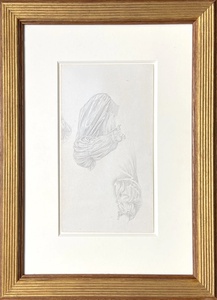| Method | Pencil |
| Artist | Sir Edward Coley Burne-Jones |
| Published | c. 1876 |
| Dimensions | 10 x 5 1/4 inches |
| Notes |
An original study sketch of sleeves for The Golden Stairs by Sir Edward Coley Burne-Jones. The sketch shows two studies of sleeves for the figure with the violin half way down the stairs in the finished oil painting, the one with space in front of her. Burne-Jones's daughter Margaret sat for the head of this figure. Burne-Jones seems to have conceived the concept of a group of beautiful musicians descending a helical stair from 1872. After beginning the actual painting in 1876, he had to rush to finish it in time to be his only exhibit at the Grosvenor Gallery four years later. FG Stephens described the descending figures "troop[ing] past like spirits in an enchanted dream. … What is the place they have left, why they pass before us thus, whither they go, who they are, there is nothing to tell." This drawing was originally bound in a sketchbook given by the artist to Sir George and Lady Lewis, which was split up for sale in 2016. Sir Edward Coley Burne-Jones, 1st Bt (1833-1898) was a painter and designer closely associated with the later phase of the Pre-Raphaelite movement. Burne-Jones met William Morris as an undergraduate of Exeter college, Oxford, whilst studying for a degree in theology. The pair went on to work very closely together on numerous decorative arts projects including stained glass windows, tapestries and illustrations. Originally intending to become a church minister, Burne-Jones never finished his degree, choosing instead to pursue an artistic career under the influence of Dante Gabriel Rossetti. Rossetti heavily inspired his early work, but by the 1860's his idiosyncratic style was beginning to develop. His mature work, however different in total effect, is rich in conscious echoes of Botticelli, Mantegna and other Italian masters of the Quattrocento. Thusly, Burne Jones' later paintings of classical and medieval subjects are some of the most iconic of the Pre-Raphaelite movement. He was at the height of his popularity during the 1880's, though his reputation began to decline with the onset of the Impressionists. He was created a baronet in 1894, when he formally hyphenated his name. Provenance: Sir George and Lady Elizabeth Lewis (a gift from the artist in 1881). Thence by descent. Condition: Framed in an ornate gold frame. |
| Framing | framed |
| Price | £10,500.00 |
| Stock ID | 53420 |

